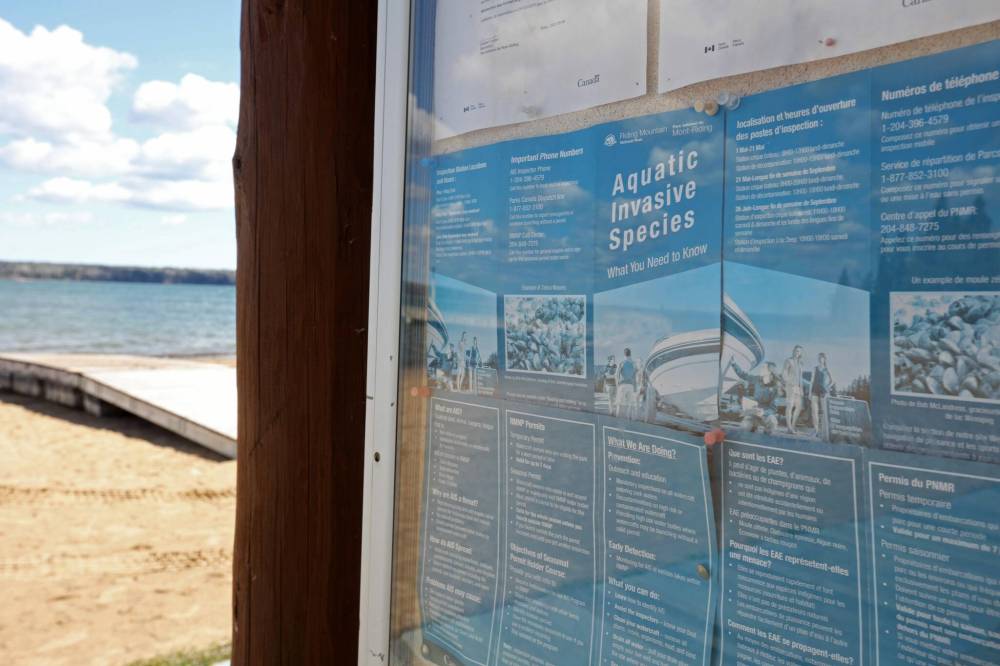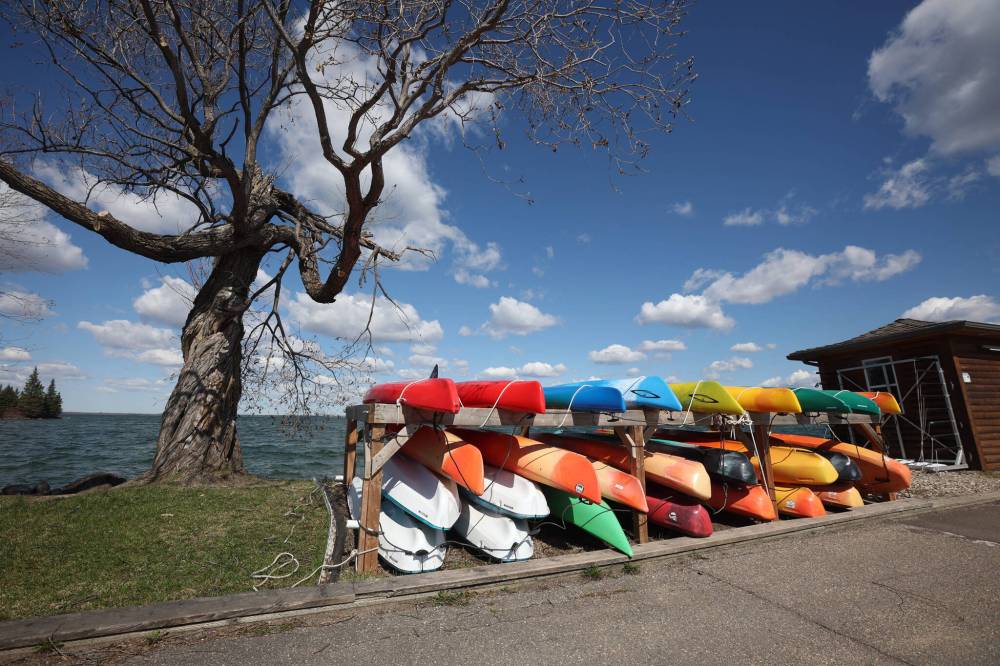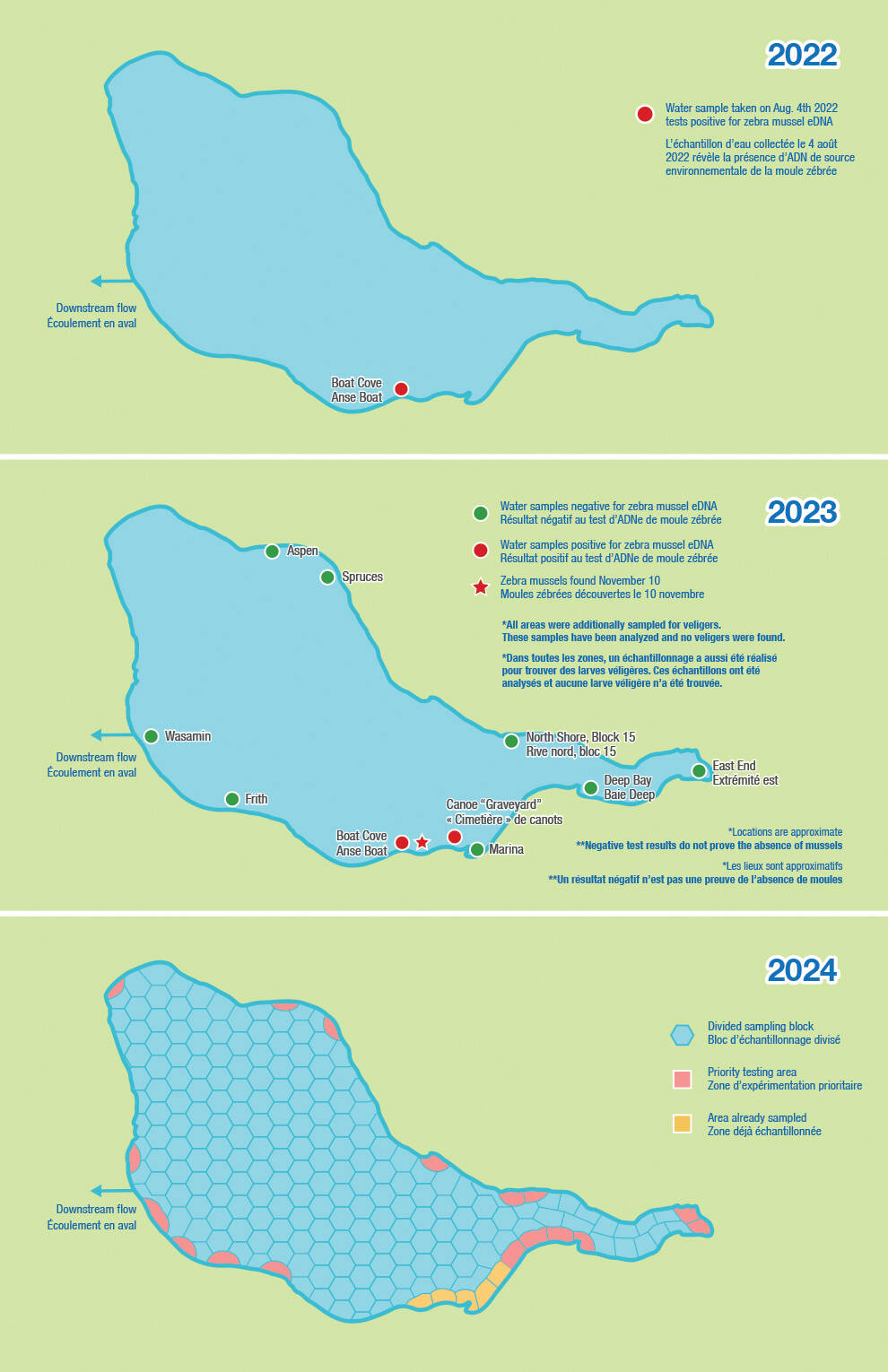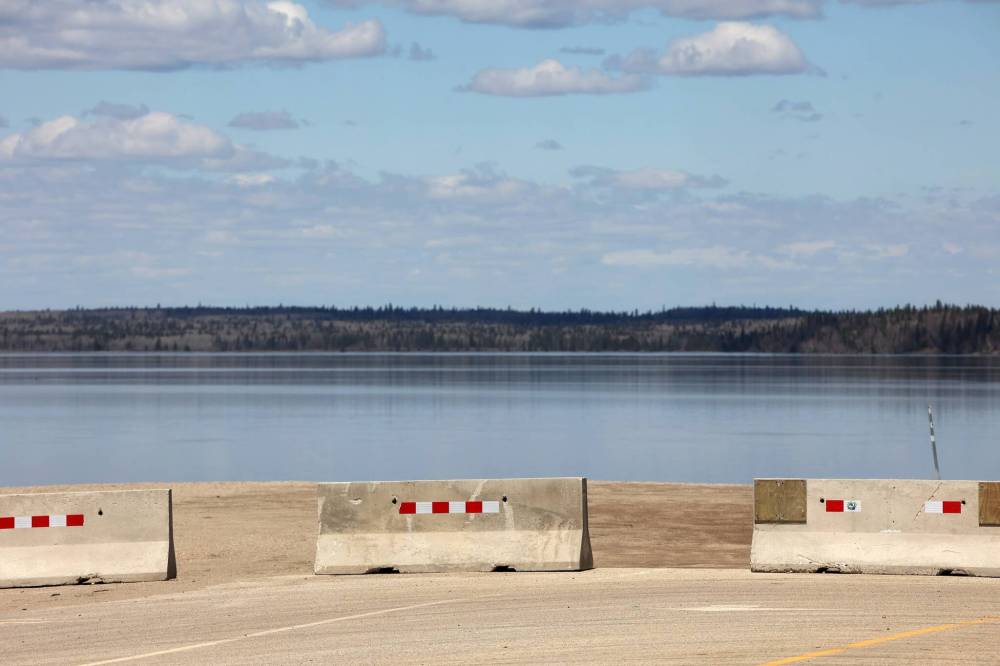Last November, researchers at Manitoba’s Riding Mountain National Park made a discovery they had been dreading for years.
In the shallow waters of Clear Lake, the park’s crown jewel, they found a piece of rope coated in a clump of 48 living zebra mussels — one of the most ecologically devastating aquatic invasive species in the country.
Parks Canada had been monitoring the lake for evidence of the fingernail-sized mollusks since 2011. Traces of zebra-mussel DNA were first confirmed earlier that year, raising alarm among park staff, local leaders and residents. But finding living mussels triggered an emergency response.
“The game changed a lot that day,” Dameon Wall, Riding Mountain’s media relations manager, says in an interview.
“There is a very small window, before those creatures become widely established throughout the water body, where it’s possible to have an intervention that entirely gets rid of them.”
A week before the May long weekend, Parks Canada issued a controversial edict banning recreational watercraft — including motorboats, kayaks, canoes and paddleboards — from Clear Lake for the 2024 summer season.
The decision rocked local business owners and provincial politicians, who worry the ban will cripple the region’s tourism-dependent economy.
But in the eyes of park staff, there’s a much greater risk on the horizon.
Zebra mussels have already invaded freshwater bodies across much of Eastern Canada and the United States. Once they take hold in a water body, they’re nearly impossible to get rid of and have devastating impacts on tourism, infrastructure and the environment.

Clear Lake is the westernmost Canadian body of water where live zebra mussels have been found. If a population becomes established, the ecological and economic impacts could spread across southwestern Manitoba and potentially over provincial borders.
“The implications of a zebra-mussel infestation here are not just for Clear Lake and are not just short-term,” Wall says. “They are in essence permanent — or at least until the next Ice Age comes along — and they would be all the way from Clear Lake to The Forks and downtown Winnipeg.”
With millions of dollars and countless aquatic ecosystems on the line, invasive species experts believe the boat ban is a necessary tool in the fight for the health of Canada’s western waterways — even though not everyone is on board.
In the winter months after last November’s discovery, Parks Canada ecologist Tim Town and a team of federal, provincial and First Nations scientists spent their days huddled in huts on the frozen lake.
The lake was divided into more than 200 sections, laid out in a honeycomb pattern and prioritized based on risk of zebra-mussel exposure. In a methodically orchestrated relay, the inspection crews worked their way across the lake on the hunt for more evidence of zebra-mussel DNA.

PARKS CANADA
Parks Canada staff collect water samples from the bottom of a frozen Clear Lake, which is where zebra mussels’ eDNA would likely be found during winter months.
First, navigation teams set up small heated shelters at predetermined co-ordinates. Then sampling teams, decked out in specialized equipment, drilled through the ice with augers, sunk stainless steel tubes (called kemmerers) to the bottom of the lake and extracted a mixture of water and sediment.
The samples were passed to the filtering teams, who worked out of a mobile lab never more than a few hundred metres away. At the lab, water samples were poured through a toonie-sized filter, similar to a coffee filter, which was then sealed, labelled and shipped to a federal laboratory in Winnipeg.
Over a period of about 40 days, Town says the crews tested nearly three-quarters of the lake, processing more than 1,000 water samples and sending nearly 600 filters to the lab.
The winter testing program was “unprecedented,” according to Parks Canada. Typically, aquatic invasive species monitoring takes place in the summer, when water is easier to access and species are generally more active.
Parks staff had already started to ramp up its testing regime after a routine sample taken in the summer of 2022 came back positive.
That one positive test, Wall says, “really caused a lot of concern for us.”
The first run of winter tests took place in the early months of 2023. All came back negative for zebra-mussel DNA.

PARKS CANADA
A Parks Canada resource management officer wears personal protective equipment to minimize contamination while filtering water during monitoring.
As the ice melted, testing frequency increased. Samples were taken from 28 lakes in the Riding Mountain region.
The 2023 summer season also came with new rules for boaters: anyone who wanted to use a boat on Clear Lake was required to get their vessel inspected by park staff, and attest the boat hadn’t been in any other lakes. Inspected boats were fitted with aluminum tags; if the boat was taken to any other water body, the tag would be removed and the boat could not come back.
“It was one lake, one boat,” Wall says.
In early November, the federal lab alerted Parks Canada that several samples taken from one of Clear Lake’s main boat launches, the aptly named Boat Cove to the west of the townsite’s beach, had tested positive for DNA. Park staff conducted a search. Their worst fears were realized upon discovery of the clump.
“It was no longer enough to just tag and seal your boat … we’re concerned now about transfer within the lake, we’re also concerned about the potential transfer out of the lake to other water bodies,” Wall says.
There are three exemptions to the ban: a commercial touring boat, a fishing and cultural-use vessel from Keeseekoowenin Ojibway First Nation, whose land borders the northwest corner of the lake, and Parks Canada’s research and emergency boats. The lake is still open for swimming, shoreline fishing and other recreational uses.
The pistol-shaped national park in western Manitoba has long been a destination for cottagers, day-trippers and back-country enthusiasts. And for thousands of years prior, the land and the lake were considered sacred to Indigenous peoples.
For many visitors, Clear Lake and the bucolic townsite of Wasagaming, with its restaurants, ice cream shops, motels and sandy beach mixed among historic Parks Canada log buildings along the southern shore, are the main draws.

TIM SMITH / THE BRANDON SUN
The Clear Lake pier in Wasagaming is a popular destination for visitors.
Which is why the boat ban hit so hard.
Since news of the ban broke, much has been made of its potential impacts on the tourism-driven economy in Wasagaming and other towns surrounding the park.
Manitoba Premier Wab Kinew expressed concern federal officials had made “a unilateral decision” without adequate consultation with local stakeholders.
Manitoba’s Economic Development, Investment and Trade Minister Jamie Moses wrote to the federal government pleading for a “balanced approach” that ensured both the health of the lake and economic stability of Wasagaming, and calling for financial support for industries that stood to lose out as a result of the ban.
In an interview, Moses says the province hasn’t studied the financial impact the boat ban could have this summer season. According to an impact assessment compiled by Parks Canada, the park is one of Manitoba’s most popular tourist destinations, seeing an average of 350,000 visitors and issuing between 8,000 and 9,000 watercraft permits each year.
“Without a healthy lake, this community would be a very different place.”–Karly McRae
“A lot of folks are scared and worried about the lake, and knowing that puts into question the long-term sustainability of tourism in that sector and what their future holds,” Moses says.
Manitoba is leaving the responsibility to mitigate potential economic impacts of the boat ban in federal hands, but has increased its aquatic invasive species budget by $500,000, most of which will be spent on new cleaning and inspection stations.
Karly McRae owns several hospitality businesses in Wasagaming, chairs the region’s destination enrichment organization and has lived on the eastern edge of the park all her life. Her children are the fifth generation of her family to call the park home.
“This place is in my blood in every way you can imagine,” she says in an interview.

TIM SMITH / THE BRANDON SUN
Karly McRae’s family ties to the region span five generations. The president of the Clear Lake Country Destination Enrichment Organization is calling for a long-term plan that protects the lake while supporting tourism.
McRae spoke to media and politicians in the months leading up to the boat-ban decision, urging Parks Canada to hold off on banning watercraft until the impacts on the local business community were fully understood. Earlier this month, she told the Free Press uncertainty around the ban had already put a dent in the season’s bookings and prompted an increase in cancellations. But at the end of the day, McRae says, the health of the lake is her first priority.
“Without a healthy lake, this community would be a very different place.”
Despite their unassuming size, zebra mussels are capable of massive, ecosystem-wide impacts. The tiny mollusks, recognized by their striped shells, are considered among the 100 most invasive species across the globe.
“It’s tough to understand sometimes because they’re so small — they’re about the size of your fingernail, a few millimetres long — but they can grow to such large population sizes within a lake,” says Scott Higgins, a research scientist at the International Institute for Sustainable Development’s Experimental Lakes Area in northwestern Ontario.

PARKS CANADA
The tiny mollusk is among the most invasive species on the planet.
What sets zebra mussels apart is their ability to reproduce — fast.
A single female mussel can produce up to one million eggs per year. Their larvae, called veligers, float until they find a solid surface to cling to. With no natural predators, densities can reach up to 700,000 zebra mussels per square metre.
Millions upon millions of mussels feeding on vital phytoplankton, or microscopic algae, has a ripple effect all the way up the food chain, Higgins says. Algae is a main food source for microscopic invertebrate animals called zooplankton. In some lakes, zebra mussels outcompete the zooplankton, leading to steep population decline.
Fewer zooplankton means less food available to smaller fish species that feed on the invertebrates, leading to a collapse in fish populations. (As an example, the Pacific salmon population collapsed in Lake Huron as a result of zebra-mussel infestation, causing long-lasting impacts to the local fishing industry.)
“For a single species, they impact almost everything else in the food web,” Higgins says.
“For a single species, they impact almost everything else in the food web.”–Research scientist Richard Higgins
While high populations of zebra mussels often improve water clarity by filtering out floating nutrients, the mussels are picky eaters and tend to avoid more toxic algaes, and can contribute to dangerous blue-green algal blooms. Those blooms have been associated with health risks to people and animals alike and can cause beaches to shut down entirely.
Worse still, their tendency to cling to vital infrastructure like water intakes, irrigation pipes and power plants can create staggering maintenance costs. Manitoba Hydro spends some $2 million annually managing the impact of zebra mussels on Hydro infrastructure in the Nelson River system.
Ontario estimates invasive mussels cost the province $75 to $91 million each year. British Columbia, which has so far avoided the zebra-mussel plague, estimates the annual costs of an invasion could range between $64 and $129 million, including up to $12.5 million in tourism losses, $92.5 million in infrastructure costs and $30 million in lost property values.
“What’s really fascinating and why zebra mussels are such a poster child of an invasive species is their capacity to move between lakes that are not connected otherwise,” Higgins says.
Their main mode of transport? Hitchhiking with humans.
Because veligers — the larvae — are impossible to see with the naked eye, they can sneak onto boat hulls, trailers or anything else that spends time submerged in water. Mussels and veligers have been known to survive long periods in bilge water, or attached to plants and other organic matter tangled onto boats and trailers. Adult zebra mussels can survive for several days outside of the water, allowing them to wait out a boater’s journey from one lake to the next.
Native to the Caspian and Black seas of Europe, the first zebra mussel in North America was found at a Lake Erie port in the 1980s. It’s assumed the mussel hitched a ride in the ballast water of a trade ship docking in ports along the St. Lawrence. Within a decade, they had spread across all five Great Lakes and into the Mississippi River.

PROVINCE OF MANITOBA
This map indicates in red the bodies of water that had been invaded by zebra mussels as of 2021. Manitoba Hydro spends some $2 million annually managing the impact of zebra mussels on Hydro infrastructure in the Nelson River system.
The first zebra mussels in Manitoba were detected at the south basin of Lake Winnipeg in 2013. According to Higgins, it’s not likely the mussels crossed the border from Ontario; the Canadian Shield lacks the calcium levels zebra mussels need to survive in large numbers, and serves as a bit of a buffer zone between the Great Lakes and the West. Instead, the mussels are believed to have travelled downstream on the Red River from the United States.
By 2021, the mussels had spread to the Hudson Bay, infesting nine major provincial water bodies, including Lake Manitoba, Lake Winnipeg and the Red and Nelson rivers.
“Saskatchewan, Alberta and British Columbia are looking at Manitoba right now going: ‘I really hope you guys deal with this, because we don’t want this spreading into our province as well,’” Higgins says.
Clear Lake offers the perfect habitat for zebra mussels. The pH is just right, the calcium levels are ideal and there are plenty of hard surfaces to cling to.
If mussels start spreading through the water system, Wall says, the impacts could reach recreational spots along the Little Saskatchewan and Assiniboine rivers. Drinking water infrastructure, including Wasagaming’s treatment plant, would suffer.
The water supply for Manitoba’s second-largest city, Brandon, would be impacted if mussels hit the Assiniboine River. Flood mitigation infrastructure — notably the Portage diversion, built to protect Winnipeg from western flooding — would see maintenance costs skyrocket.

TIM SMITH / THE BRANDON SUN
Pamphlets about aquatic invasive species are posted along the Clear Lake beach.
For the seven First Nations with cultural, historical and traditional relationships to Clear Lake and Riding Mountain park, a permanent invasion would be devastating.
“A traditional fishery on Clear Lake is a way of life, a practice to maintain our culture, ceremonies, ancestral teachings and traditions, and to exercise our responsibilities towards the lake and the beings within,” Keeseekoowenin Ojibway First Nation Chief Dwayne Blackbird wrote in a statement.
“We fish to feed our people, as we have done at Clear Lake for centuries.”
Management and prevention strategies have focused on changing human behaviour. Governments across the country — including Manitoba — have adopted “clean, drain and dry” messaging urging boaters to decontaminate and dry out their watercraft to avoid spreading invasive species.
Many provinces provide funding for boat-cleaning stations at popular recreation spots. Some mandate boaters stop at provincially run inspection stations before launching in new waters. Many have begun restricting — or banning — boat access altogether.

TIM SMITH / THE BRANDON SUN
Kayaks offered for rent at the Clear Lake Marina along the pier in Wasagaming. Parks Canada announced earlier this month that all personal watercraft, including motorized boats, canoes, kayaks and paddle boards, will be banned from use on Clear Lake.
Singush Lake, in Manitoba’s Duck Mountain Provincial Park, restricts boat access to cottage owners, who must agree not to launch their vessels anywhere else.
In 2019, Waterton Lakes National Park in Alberta’s southwest corner instituted a 90-day quarantine for all motorized boats entering the park.
In April, Parks Canada announced it was expanding restrictions, prohibiting anyone from bringing non-motorized boats into the park, including inflatable kayaks, paddleboards and canoes. In its decision, Parks Canada cited the risks of zebra and quagga mussels, whirling disease and Eurasian water-milfoil.
National parks like Yoho and Kootenay, in British Columbia’s Rocky Mountains, have gone a step further — opting this spring to shut down lakes to boating and fishing altogether.
Other popular national parks like Banff and Jasper have not yet enacted boating bans, but require visitors to fill out a permit each time they launch a canoe, kayak, paddleboard or inflatable toy in a lake or river.
Fines for breaching rules can range from under $200 to more than $2,500 in Manitoba. Alberta changed its legislation in 2015 to make it mandatory for drivers transporting a boat of any kind to stop at watercraft-inspection stations, along with instituting fines of up to $100,000.
Boat rules aimed at curbing the spread of invasive species also extend beyond Canada’s borders, with mandatory inspection programs existing in the U.S. from Yellowstone to the Adirondacks and from state parks in Wyoming to Arizona.
But these restrictions aren’t enough to satisfy Canadians worried about invasive species spreading from south of the border. Last year, the Okanagan Basin Water Board in B.C. called on the provincial government to ban U.S. boats from crossing the border to stop the spread of zebra mussels.
The idea is clear: stop boating now, or zebra mussels will ruin boating in the future.
Like many business owners in Wasagaming, McRae believes Parks Canada should have done more to communicate the impact of management strategies such as a boat ban.
According to Wall, the agency held two town hall meetings last fall, an online information session in January and conversations with provincial and municipal leaders, local businesses, environmental groups, anglers, cottagers, cabin owners and First Nations leadership.
McRae says the community found out about the watercraft restriction through the media.
Going forward, she hopes to see Parks Canada, the provincial government and other stakeholders working together to find long-term, cross-jurisdictional solutions that will protect Clear Lake, the surrounding water bodies and the park’s attractiveness as a tourism destination.
In a letter to Parks Canada earlier this year, Christian Robin, president of the Clear Lake Cabin Association, said regardless of what decision was made for this summer, the organization “does not support a long-term vision of Clear Lake that does not include the ability to use watercraft.”

TIM SMITH / THE BRANDON SUN
Christian Robin, president of the Clear Lake Cabin Association, says a long-term vision for the lake must include the use of watercraft.
Robin stressed the cabin association would support “the permanent implementation of stricter controls” such as one-boat, one-lake rules for all kinds of watercraft and increased education, communication and signage.
While McRae is not opposed to some restrictions on watercraft (her preference would also be a continuation of the one-boat, one-lake rule), she believes the federal government should co-ordinate with provincial staff to ensure the regulations can be successful. She also hopes to see all levels of government continue to tout Clear Lake and Riding Mountain park as one of the province’s jewels.
“We’re fixated on this watercraft ban, but Riding Mountain National Park is over 3,000 square kilometres of basically untouched wild country,” she says.
“Without presenting how incredible this place is to Canadians, it’s very hard for them to value it and want to protect it.”
According to Parks Canada, all of the samples from this year’s winter testing program on Clear Lake came back negative.
While that’s hopeful news, Town, the Parks Canada ecologist, says it’s too soon to rule out the possibility of a growing mussel population.

PARKS CANADA
A Parks Canada map shows areas of Clear Lake tested for the presence of zebra mussels over the last three years.
“We might not have hit a zebra mussel right on the head, but it allows us to determine that the lake’s not totally infested with zebra mussels,” he says. “We have reason to believe that the population is fairly isolated at this point.”
If that’s true, it’s a positive sign. Isolated mussel outbreaks can be contained and, if caught in time, eradicated.
Canada approved potash as a pesticide treatment for zebra mussels in 2022. The potassium in potash is safe for humans, but kills sensitive zebra mussels. (A downside: potassium will kill native freshwater mussels too, Higgins says.) The mussels can also be eliminated with benthic mats — essentially large tarps — that starve the mussels of oxygen and nutrients over a period of several months.
The biggest barrier to treating water bodies for zebra mussels is cost. The more the mussels spread, the more expensive treatment gets. Wall says it would cost upwards of $500 million to treat the entirety of Clear Lake, but a small infestation can be managed in a cost-effective way.
Town says it’s too early to tell whether the population is as contained as park staff hope, or what exact eradication measures the department will take. But limiting the potential for further spread will help make eradication decisions a little easier.
That’s where the boat ban comes in.
Wall says the economic implications of banning recreational boating aren’t lost on park staff. But having boats travel through the lake increases the risk of mussels expanding from the isolated area around Boat Cove, exacerbating an already expensive eradication effort and threatening the health of bodies of water downstream.

TIM SMITH / THE BRANDON SUN
Concrete barriers block vehicle and boat access to the Wasagaming boat launch at Clear Lake.
“It’s important for everybody to remember that if zebra mussels become established in this lake there are permanent economic and ecological impacts that will have to be borne every single year,” he says.
“We know people come to Clear Lake to make memories, and we’re here to help them with that. It’s just going to look a little different this year.”
Clear Lake is still open to the public and other lakes in the park are accessible to boaters. The park’s many biking, hiking and horseback riding trails are open too.
The boating restrictions are temporary measures, he stresses. If new data show it’s safe to re-open the waters, Parks Canada will re-evaluate the rules.
In the meantime, Wall says park staff feel the weight of their responsibility, not only to Clear Lake, but to the many interconnected waters it touches.
“I cannot hear that this is a lost cause,” he says. “I just can’t take it. We have to try.”
julia-simone.rutgers@freepress.mb.ca

Julia-Simone Rutgers
Reporter
Julia-Simone Rutgers is a climate reporter with a focus on environmental issues in Manitoba. Her position is part of a three-year partnership between the Winnipeg Free Press and The Narwhal, funded by the Winnipeg Foundation.
Our newsroom depends on a growing audience of readers to power our journalism. If you are not a paid reader, please consider becoming a subscriber.
Our newsroom depends on its audience of readers to power our journalism. Thank you for your support.